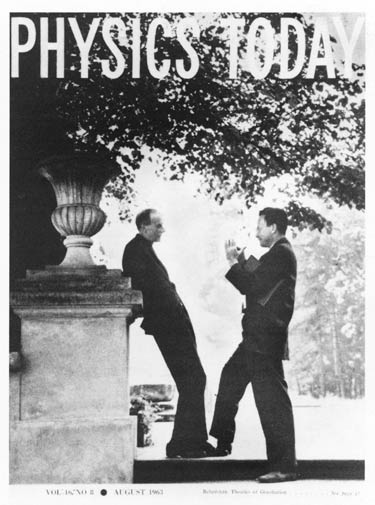
This Article From Issue
July-August 2007
Volume 95, Number 4
Page 357
DOI: 10.1511/2007.66.357
Traveling at the Speed of Thought: Einstein and the Quest for Gravitational Waves. Daniel Kennefick. xiv + 319 pp. Princeton University Press, 2007. $35.
Fifty years ago, theoretical physicists were in complete confusion and disagreement over whether Einstein's gravitational waves were real, and if so, what their nature was. Today, experimental physicists operate costly gravitational-wave detectors paid for by sober funding agencies in many countries; over the past 20 years, outlays have totaled perhaps half a billion dollars, and a further two billion dollars of investment is currently planned, much of which might be spent even before any waves have been successfully detected.Traveling at the Speed of Thought: Einstein and the Quest for Gravitational Waves, by physicist and historian Daniel Kennefick, tells the fascinating story of how gravitational-wave theory, which was a hive of controversy for many years, eventually became a dead certainty.

From Traveling at the Speed of Thought.
This is not a Cinderella story. No fairy godmother provides magical enlightenment; no handsome prince lifts gravitational-wave theory out of obscurity and places it, beautiful, at the apex of research. Rather, this is a messy case of mathematical confusion, battling egos, uncertain physical intuition and divergent notions of physics. Historically, relativity theorists have been either skeptics (Kennefick's term for people who thought gravitational waves did not exist or were very different from their electromagnetic analogues) or nonskeptics.For a time (beginning in the 1930s) the controversy took place out of the spotlight and was ignored by most physicists. When the disputes over the nature of gravitational waves finally moved to center stage (after about 1960), they seemed to get even more intense, to a degree that astonished many physicists in other areas. Traveling at the Speed of Thought is not an uplifting tale, but it is a revealing story about raw science. Battles of this sort are how science sometimes makes progress, and indeed, from our current vantage point we can see that the progress was enormous.
Kennefick's account begins with early notions of gravitational waves (which go back as far as the French physicist Pierre-Simon de Laplace [1749-1827]) and finishes roughly around 1985, when the consensus among physicists became strong enough that they could begin to pry large sums of money for the development of suitable detectors out of the funding agencies of half a dozen countries.
With the publication of Einstein's general theory of relativity in 1915, physicists finally had a good theory of gravity with which to compute gravitational waves. Unfortunately, the nonlinearity and coordinate freedom of the theory proved baffling: Nonlinearity meant that waves could create more waves, so that there was no clear distinction between waves and their dynamical sources; and the theory's coordinate freedom allowed one to construct pure-coordinate "waves" that moved at any speed, making it hard to find a clear way of separating coordinate effects from "real" waves. As different physicists tried different ways of resolving these problems, conflicts and controversies developed. The book ranges widely over these different approaches, richly portraying the rivalries among strong personalities and ambitious people, the collisions between traditional and new ways of thinking, and the divergent paths taken by different schools of research grouped around key players.
The conflict and confusion about gravitational waves went to the heart of general relativity and our current scheme of theoretical physics. It is true that in its early years the struggle was played out on the periphery of physics, which was preoccupied with developing quantum mechanics and quantum field theory, and with understanding the nature of the fundamental building blocks of matter. But the issue of the nature and even the reality of gravitational waves was never peripheral, and during the 1950s it became clear that it had to be addressed.
All of physics was being described by relativistic fields, which propagate at or below the speed of light. Einstein had provided a relativistic-field description for gravity in 1915, and yet even by 1955 physicists still could not agree on what kind of physical interactions, if any, propagate according to this theory, and at what speed. If gravity was ever to be quantized, classical gravitational waves had to be understood first. So in the 1950s some big names in physics got involved in the problem—Richard Feynman, John Wheeler, Lev Landau, Hermann Bondi—and the simmering cauldron of controversy really began to boil.
It would be another 30 years before some new mathematics, a new generation of young physicists, and the crucial discovery and long-term observation of the slowing (presumably by the emission of gravitational-wave energy) of the Hulse-Taylor binary pulsar PSR 1913 + 16 would finally dispel the last remnants of controversy. Gravitational waves do exist, they move at the speed of light, they carry energy and angular momentum away from their sources, they act on objects in their paths (such as detectors) via time-dependent tidal gravitational forces, and they invite quantization. Indeed, our present confidence is great enough that if gravitational-wave detectors do not eventually register these waves, we will have to acknowledge that something is deeply wrong not just with general relativity but with theoretical physics as a whole. This recognition of the importance of the undertaking is one of the principal justifications for the large financial investment in these detectors.
Kennefick's marvelous study is one of the first to address in detail the history of the evolution of relativity after the theory's publication by Einstein in 1915. During 2005, the centennial year of the development of special relativity, attention was focused on Einstein's achievements in the incredible decade from 1905 to 1915. More recently, a number of important works on how Einstein created general relativity have been published, such as the massive four-volume study The Genesis of General Relativity: Sources and Interpretations, edited by Jürgen Renn (Springer, 2007).
But there is much more to the story of general relativity than its invention. Although general relativity was mathematically complete when it emerged in 1915, it lacked a physical interpretation for most of its predictions, and the development of a physical framework for the theory required most of the 20th century. Gravitational waves were not the only place where physicists puzzled over how to make sense of the theory of general relativity. Black holes, compact stars, singularities, gravitational lensing, the Big Bang—all of these had to be understood and integrated into the larger context of physics and astronomy. But the theory of gravitational radiation was arguably the most difficult of all, and so it is particularly appropriate that Kennefick should have chosen to study it.
And what a tough subject it is! To begin with, Kennefick's nonmathematical exposition attempts to describe a controversy that was rooted in the mathematical complexity of general relativity. To add to the difficulty, Kennefick has to track a debate that evolved on several fronts among people who did not always communicate effectively (because of wars, iron curtains, language barriers, large distances or personal animosities). The same errors and missteps occurred repeatedly. Finally, Kennefick has to deal with a number of deep issues in physics at the same time—not just the dynamical behavior of gravity, but also the equation of motion of self-gravitating bodies in general relativity; the question of whether and how to impose the arrow of time on the problem (because after all, waves should go out from their sources and not converge on them); and most troublesome, the treatment of energy in general relativity and its exchange with the energy of localized physical systems.
Kennefick is uniquely qualified to tackle such things. He earned a two-subject Ph.D. at Caltech in 1997, half in general relativity (supervised by Kip Thorne) and half in the history of science (supervised by Diana Buchwald). This book is based on his doctoral research. He burrowed into archives, interviewed key players and gradually built up his own perspective on the issues. Although the controversy has ended with a strong consensus about the physics of gravitational waves, I know that many of the participants retain strong feelings about others who were involved, and the pain left over from some of the arguments lives on. Kennefick has had to deal with these animosities and prevent them from coloring his account, and I believe he has succeeded. He is scrupulously fair and sympathetic to all the main characters, and he manages to focus primarily on the scientific content of the disagreements. If I have any criticism, it is that his interviews and most of his sources are now at least 10 years old, and I believe that the field's perspective on some of the key controversies has continued to evolve in the past decade, especially as post-Newtonian computations have moved to center stage in the gravitational-wave detection program. But that is a minor shortcoming; after all, in writing any history you have to draw a line somewhere.
Traveling at the Speed of Thought nicely complements Harry Collins's 2004 book Gravity's Shadow [Editor's note: Reviewed in the September-October 2005 issue], which is an account of the efforts to detect gravitational waves. Collins's book traces the experimental effort from Joseph Weber's initial bar detector to the present day and clearly shows the impact that the resolution of the theoretical controversy over gravitational waves had on the prospects for detector development. Kennefick worked with Collins after finishing his doctorate, but whereas Collins is a sociologist looking at how big science works, Kennefick remains a historian of the gravitational-wave controversy. I hope that this trailblazing study will be followed by even more historical work on the way in which general relativity as a whole made its transition from a mathematical model of the gravitational field to an essential part of our view of the physical world.

American Scientist Comments and Discussion
To discuss our articles or comment on them, please share them and tag American Scientist on social media platforms. Here are links to our profiles on Twitter, Facebook, and LinkedIn.
If we re-share your post, we will moderate comments/discussion following our comments policy.